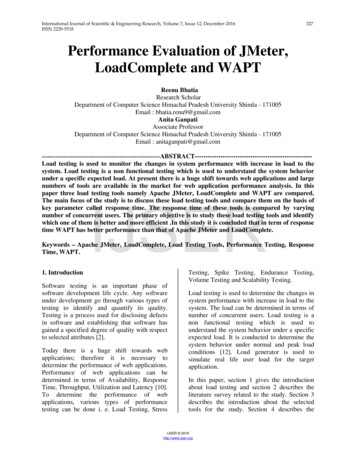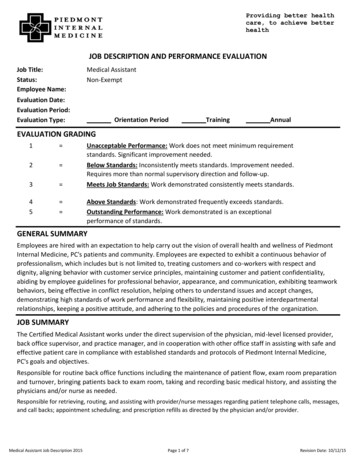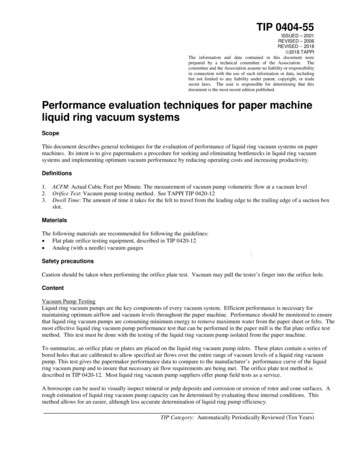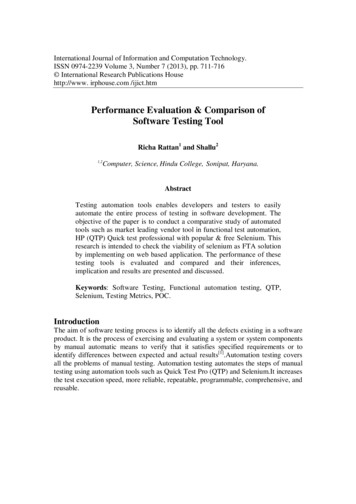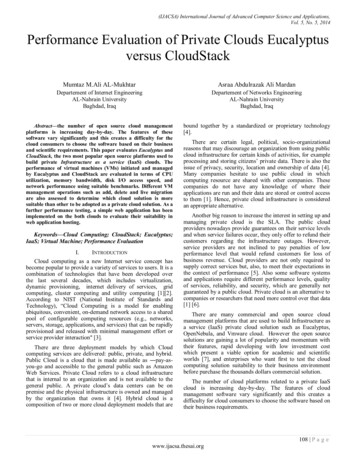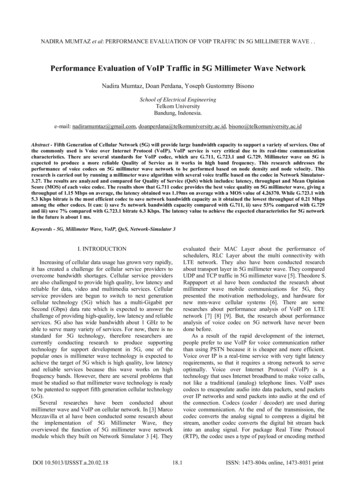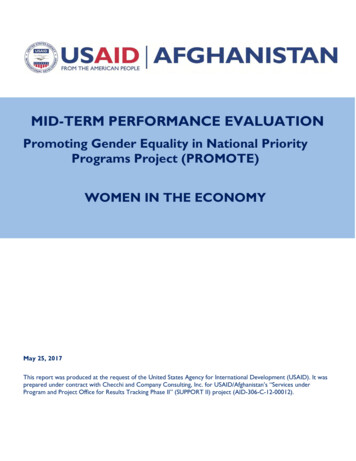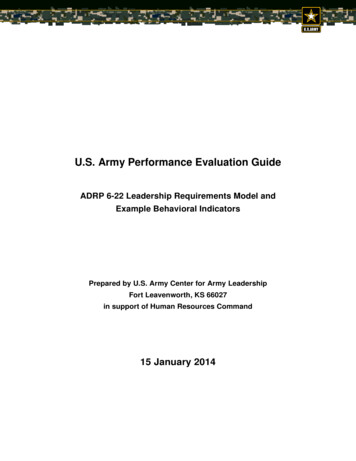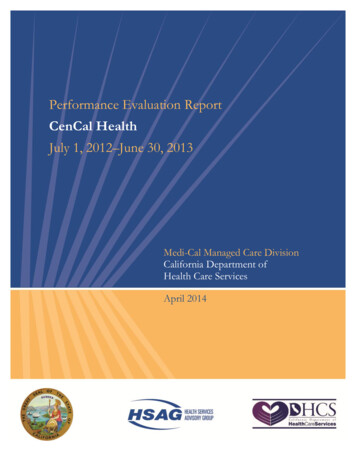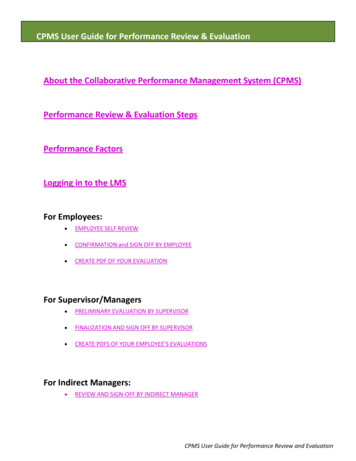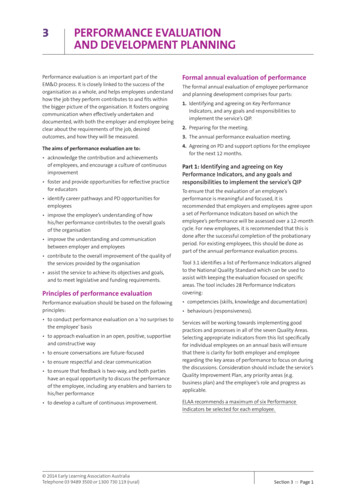
Transcription
3PERFORMANCE EVALUATIONAND DEVELOPMENT PLANNINGPerformance evaluation is an important part of theEM&D process. It is closely linked to the success of theorganisation as a whole, and helps employees understandhow the job they perform contributes to and fits withinthe bigger picture of the organisation. It fosters ongoingcommunication when effectively undertaken anddocumented, with both the employer and employee beingclear about the requirements of the job, desiredoutcomes, and how they will be measured.Formal annual evaluation of performanceThe aims of performance evaluation are to:4. Agreeing on PD and support options for the employeefor the next 12 months. a cknowledge the contribution and achievementsof employees, and encourage a culture of continuousimprovement f oster and provide opportunities for reflective practicefor educators i dentify career pathways and PD opportunities foremployees i mprove the employee’s understanding of howhis/her performance contributes to the overall goalsof the organisation i mprove the understanding and communicationbetween employer and employees c ontribute to the overall improvement of the quality ofthe services provided by the organisation a ssist the service to achieve its objectives and goals,and to meet legislative and funding requirements.Principles of performance evaluationPerformance evaluation should be based on the followingprinciples: t o conduct performance evaluation on a ‘no surprises tothe employee’ basis t o approach evaluation in an open, positive, supportiveand constructive way to ensure conversations are future-focused to ensure respectful and clear communication t o ensure that feedback is two-way, and both partieshave an equal opportunity to discuss the performanceof the employee, including any enablers and barriers tohis/her performance to develop a culture of continuous improvement. 2014 Early Learning Association AustraliaTelephone 03 9489 3500 or 1300 730 119 (rural)The formal annual evaluation of employee performanceand planning development comprises four parts:1. I dentifying and agreeing on Key PerformanceIndicators, and any goals and responsibilities toimplement the service’s QIP.2. Preparing for the meeting.3. The annual performance evaluation meeting.Part 1: Identifying and agreeing on KeyPerformance Indicators, and any goals andresponsibilities to implement the service’s QIPTo ensure that the evaluation of an employee’sperformance is meaningful and focused, it isrecommended that employers and employees agree upona set of Performance Indicators based on which theemployee’s performance will be assessed over a 12-monthcycle. For new employees, it is recommended that this isdone after the successful completion of the probationaryperiod. For existing employees, this should be done aspart of the annual performance evaluation process.Tool 3.1 identifies a list of Performance Indicators alignedto the National Quality Standard which can be used toassist with keeping the evaluation focused on specificareas. The tool includes 28 Performance Indicatorscovering: competencies (skills, knowledge and documentation) behaviours (responsiveness).Services will be working towards implementing goodpractices and processes in all of the seven Quality Areas.Selecting appropriate indicators from this list specificallyfor individual employees on an annual basis will ensurethat there is clarity for both employer and employeeregarding the key areas of performance to focus on duringthe discussions. Consideration should include the service’sQuality Improvement Plan, any priority areas (e.g.business plan) and the employee’s role and progress asapplicable.ELAA recommends a maximum of six PerformanceIndicators be selected for each employee.Section 3 : : Page 1
SECTION 3 : : PERFORMANCE EVALUATION AND DEVELOPMENT PLANNING continuedIf appropriate Performance Indicators cannot be identifiedfrom the list provided in Tool 3.1, ELAA recommends thatthe employer and employee agree on a set of indicators orgoals appropriate to the employee’s role. The positiondescription of the employee may provide guidance in thisprocess.Preparation should be undertaken separately by employerand employee. The preparation undertaken by theemployee will involve reflecting on his/her ownperformance during the year, successes, challenges, and aconsideration of the PD he/she would like to undertake toassist in improving performance.Included in each Performance Indicator are referencecodes to the standards set out in the current EBA thatapplies to most teachers and educators (VECTAA 2009).Employers must ensure that the reference to thestandards in the EBA are reviewed and updated when anew EBA replaces the existing EBA, if applicable toemployees.The preparation undertaken by the employer will involve areflection on the employee’s performance during the year,including observations etc. (Refer to Conducting EmployeePerformance Observations further in this section.)Contribution to any organisational goals or individualgoals should also be considered and negotiated betweenthe employer and employee. Goals must be clear andachievable by the employee within the evaluation periodand resourced appropriately by the employer.The setting of Key Performance Indicators, goals andresponsibilities for the service’s QIP, and organisationaland individual goals etc. is a joint decision between theemployer and employee, and is subject to ongoingmonitoring and review at the end of each 12-month cycle.Please note: Tool 3.1 is recommended as a guide foridentifying and agreeing on a set of PerformanceIndicators and any goals and responsibilities towardsachieving the service’s QIP. This then forms theframework on which the assessment will be based.Services may tailor this tool to suit their requirementsand/or individual employee’s needs, or use analternative evaluation process.Part 2: Preparing for the meetingPreparation for the performance evaluation meeting byboth the employer and employee will ensure that thediscussion is meaningful and focused, and is beneficial toboth parties. The extent of preparation may vary betweenindividuals. If EM&D has been implemented appropriatelywithin a culture of ongoing dialogue and opencommunication between employer and employee,preparation for the evaluation meeting should requireminimal time. 2014 Early Learning Association AustraliaTelephone 03 9489 3500 or 1300 730 119 (rural)Employers and employees may choose to structure theirpreparation based on the documentation used in theactual evaluation process (refer to Tool 3.2: PerformanceEvaluation Summary).Part 3: The annual performance evaluation meeting(usually conducted at the end of the year or at theanniversary date of the employee, with a formalmid-year review)The annual performance evaluation meeting involves theemployer and employee meeting to discuss theperformance of the employee over the past 12 months,the employee’s successes, any challenges and PDundertaken. It is assumed that both the employer andemployee come prepared for this meeting to discuss theirassessment and reflections.It may involve the following additional steps:1. gathering evidence as required to demonstrateachievements, particularly if there are significantinconsistencies in the assessments undertaken by theemployer and employee (refer to Tool 3.6: SupportingEvidence Guide)2. planning, selecting and confirming the KeyPerformance Indicators (ELAA recommends amaximum of six), any goals and Quality ImprovementPlan (QIP) areas to be the focus of the employee for thenext 12 months (refer to Tool 3.3: Performance andDevelopment Planning)3. documenting the agreement reached and signing inproof of acceptance.Section 3 : : Page 2
SECTION 3 : : PERFORMANCE EVALUATION AND DEVELOPMENT PLANNING continuedPart 4: Agreeing and developing the employeeprofessional development plan p rovide feedback on the employee’s performance, andacknowledge successes and challenges(usually drafted at the time of review with confirmationat the start of a new year) e nsure that the professional development plans thathave been agreed with the employee are beingimplemented by the employer.This part of the evaluation process involves creating aplan to support the professional development of theemployee and includes the following: d iscussion with the employee to identify developmentand support needs i n consultation with the employee, selection ofappropriate courses, conferences and PD strategies d ocumentation of the individual development plan forthe next 12 months (refer to Tool 3.3: Performance andDevelopment Planning) a pproval of the agreed individual development plan bythe employer, and allocation of appropriate resources toenable the employee to undertake the agreed PD.The discussions at this review meeting should bedocumented and placed in the employee’s file, and shouldform part of the formal performance evaluation meetingheld annually (refer to Tool 3.4: Mid-year review).The mid-year review should be viewed as a checkpoint forthe employer and employee to reflect on and discussprogress, especially if time for ongoing dialogue has beenlimited. ELAA strongly recommends that organisationsmake an effort to conduct these mid-year reviewmeetings to enrich the EM&D process for employees andthe organisation as a whole.Please note: When developing the professionaldevelopment and support options for teachers andeducators, employers must ensure they are inaccordance with the enterprise agreement applicableat that time.The mid-year reviewFormal performance evaluation meetings described aboveare held once a year, at a set time during the year (e.g.November each year or at the anniversary date of theemployee’s commencement). It is good practice to havean informal review meeting mid-way through the year.This meeting is based on a ‘no surprises to the employee’principle, meaning that this meeting is not used as thefirst opportunity to raise serious concerns (if any) aboutthe employee’s performance. Both the employer andemployee should raise any serious concern at the timethey occur.The purpose of this mid-year review meeting is to enablethe employee and the employer to: m eet and discuss how the employee is tracking inrelation to the agreed Key Performance Indicators, goalsand responsibilities in relation to the service’s QIP etc. 2014 Early Learning Association AustraliaTelephone 03 9489 3500 or 1300 730 119 (rural)Section 3 : : Page 3
SECTION 3 : : PERFORMANCE EVALUATION AND DEVELOPMENT PLANNING continuedCrucial conversations – providing feedbackEffective communication is vital to managingperformance and can ensure a harmonious workingrelationship and workplace. This includes all areas ofEM&D such as articulating the service’s philosophy andgoals, expectations of the role, having regular andmeaningful conversations about the performance of anemployee and his/her support needs etc.Creating an environment of open and honestcommunication can also lead to better outcomes forchildren and their families by fostering greaterunderstanding between the employer and employee,improving relationships and strengthening collaboration.Examples of some of the crucial conversations betweenan employer and an employee are: a rticulating the service’s philosophy, goals and strategicplan c larifying the role of the employee and the service’sexpectations in relation to his/her employment determining goals and priorities for the current year r egular catch-up (preferably monthly) with theemployee to ensure that he/she feels well supported toperform his/her role p roviding meaningful feedback about the employee’sperformance d iscussing any concerns relating to performance assoon as they arise c onducting formal performance evaluation discussionsmid-year and annually h aving conversations with the employee regarding his/her professional development and career aspirations.When communicating with an employee, employersshould ensure there is very little room for ambiguity, andthe matter being communicated is understood clearly bythe employee. Communication that is clear, goal-focused,de-personalised, sensitive and conveyed with empathy ismore likely to elicit a positive response from theemployee, than communication that is ambiguous andfault-finding.Why provide feedback?Feedback is the most significant way in which anemployer can communicate to the employee how his/herwork is being perceived, and is one of the critical roles ofthe employer. Most employees strive to do their best in 2014 Early Learning Association AustraliaTelephone 03 9489 3500 or 1300 730 119 (rural)their roles and receiving regular feedback can assistemployees to understand how their work is perceived bythe employer.Challenges with feedbackThere can be a number of challenges associated withproviding feedback to employees. Some complaints aboutfeedback include that: e mployees do not get any feedback from their employerabout how they are going t he only feedback employees get is when somethinggoes wrong feedback is delivered inappropriately/insensitively f eedback is very subjective and comes across ascriticism e mployees are told what is wrong but are not providedwith sufficient guidance about what is required, whatneeds to change and how to make these changes.Some of the challenges associated with providingfeedback may arise from the employer’s level of comfortin providing feedback and facing confronting situations.However, leaving concerns about an employee’sperformance unaddressed may, in the long term, impacton the service and the quality of the service provided. It isalso unfair to the employee, who has remained unawareof the concern and therefore has not been provided withan opportunity to address and improve his/herperformance.Tips for providing feedback M ake both positive and constructive feedback regularand timely (as soon as possible after the event). When providing feedback about concerns:– plan your feedback and make it constructive– provide specific examples i.e. based upon evidenceand facts– focus feedback on the employee’s observed behaviourand avoid making feedback personal. E ngage in dialogue and encourage the employee toparticipate. Do not make the discussion top-down. E nsure that the employee understands the concernsand expectations, and leaves knowing how to addressthe concerns. E nsure that the employee understands what support isavailable and how to access it.Section 3 : : Page 4
SECTION 3 : : PERFORMANCE EVALUATION AND DEVELOPMENT PLANNING continued I f there is a follow-up process agreed to, ensure that theemployee knows when it will occur, and what he/she isexpected to demonstrate i.e. improvement inperformance, training and development etc.As with any conversation, building good rapport with theemployee will make the conversation easier. Rather thanrushing straight into feedback, be sure to take some timeto build a positive and harmonious environment first.Structuring feedbackThere are many models of providing feedback and thesecan help employers/reviewers structure the feedbackdiscussion to make it more effective. The following aretwo examples that can be implemented in a service:Model 1 – THE FEEDBACK SANDWICHThe feedback sandwich is a commonly used model forproviding feedback. The feedback sandwich is so namedbecause it ‘sandwiches’ the concerns or areas forimprovement between positive comments. This model isvery effective when the employee’s performance is mostlyproductive and there are minor areas of improvementrequired.Positive: Begin the feedback by identifying something theemployee has done well. Starting with the positivefeedback helps build the relationship and confirms thatthe employee is generally performing well.Constructive: Next, address the areas where theemployee’s performance does not meet expectations andthere is scope for improvement. The key is to beconstructive and focus on what the employer would likethe employee to do instead of his/her current behaviour.Positive: Finish on a positive note, highlighting theemployee’s greatest achievement. This will ensure thatthe employee leaves the meeting secure in the knowledgethat his/her contribution is acknowledged and valued,and is inspired to address the concern identified.A – Actions: Define what the person is doing well or notso well, depending on the situation. These actions/behaviours must have been observed, and must becapable of being explained clearly to the employee withexamples.I – Impact: Describe the effects of these actions on otherpeople including the person providing the feedback. Theimpacts can be positive or negative depending onwhether it is to reinforce a positive behaviour or changean inappropriate behaviour. Exploring a negative impactprovides the employee with a reason, and usually themotivation to change.D – Desired outcome: Identify ways in which tasks can bedone more effectively in the future. This could begenerated as a brainstorm between the employer andemployee, rather than the employer having all theanswers.Landsberg, M. (1997), The Tao of Coaching, Harper CollinsBusiness, LondonEnsuring feedback is two-wayIt is important to plan and structure feedback, and theplan is just the starting point. The real focus is on theconversation between the employer and employee.Constructive feedback needs to be an exploratorydiscussion in which both parties contribute and equallyshare the responsibility of planning the best solutionmoving forward.Employers must be open to establishing facts and thecontext for the behaviour that was witnessed,acknowledging that the environment in which thebehaviour occurred may have impacted on the actualbehaviour. An important part of this conversation is toensure that the employee is offered appropriate supportto improve performance.Model 2 – AID FOR FEEDBACKThis model is excellent to acknowledge positiveperformance or for assisting employees to understandwhy a particular behaviour is inappropriate, hencegenerating the desire for change. This model adopts athree-step approach as described below. 2014 Early Learning Association AustraliaTelephone 03 9489 3500 or 1300 730 119 (rural)Section 3 : : Page 5
SECTION 3 : : PERFORMANCE EVALUATION AND DEVELOPMENT PLANNING continuedDEVELOPMENT AND SUPPORT OPTIONSCoachingResearch shows that educators who are actively involvedin their own development are more motivated andprovide better learning and development outcomes forthe children they engage with. Therefore, providingopportunities for ongoing development of employees is acritical consideration for employers in the EM&D process.Coaching is usually a one-on-one relationship that focuseson building competence or skills to achieve a specific goal.The process can be formal or informal, with the personwho provides the coaching assisting the other person todevelop in a particular area. Coaching is results-orientatedand focused on the ‘here and now’.There are many options for supporting employeedevelopment. Effective organisations utilise a variety ofoptions in combination to support targeted developmentfor employees as they move through their career.Coaching can be provided by a supervisor or manager, orby an experienced peer.It is important that the employer and employee discussappropriate development and support options that willmeet the needs of the employee, the service and theemployer. Further guidance on options available in thelocal area may be sourced through local government,other early learning services, peak bodies or trainingorganisations etc. Consideration in the choice ofappropriate development options for each employeeinclude relevance, cost, time required, reputation of theprovider etc. The decision should be made jointly by theemployer and employee.There are several development and support optionsavailable to choose from. These are described below.Peer supportPeer support is when two employees work closelytogether. They
3 PERFORMANCE EVALUATION AND DEVELOPMENT PLANNING Formal annual evaluation of performance The formal annual evaluation of employee performance and planning development comprises four parts: 1. Identifying and agreeing on Key Performance Indicators, and any goals and responsibilities to impl


